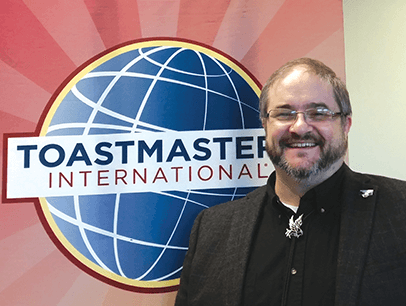Remember your Ice Breaker? I sure remember mine. My throat was dry and my face was burning; I felt like I’d been stranded in the desert for a week. The sheet of notes I was holding amplified the shaking in my hands until it looked like I was waving a white flag. I felt like I was taking a huge risk by standing there, speaking in front of everyone while my body clearly wanted me to surrender.
Fast-forward two years: I had given countless more speeches, served as club president and vice president education, and could speak in front of my club without batting an eye or breaking a sweat. I had this public speaking thing down.
Or so I thought.
The Spring Speech Contest was coming up, and I decided to compete. My speech was great, and I felt confident. The view from my cozy little perch in the center of my comfort zone was rosy. The club and area contests were a breeze—I took first place in both. There was no telling how far I’d go.
But then, when my name and speech title (and then speech title and name) were announced at the division contest, my shaking legs could barely carry me to the front of the room. My voice lacked the force and energy needed to convey my message, and my jokes fell flat.
Looking out on that sea of faces I didn’t recognize, speaking in a situation where the stakes were high, I felt like I was giving my Ice Breaker all over again. The comfort zone I had built up by speaking to my own club didn’t extend nearly as far as I thought it would—and I didn’t realize I was breaching its borders until it was too late.
That’s the danger of comfort zones; once they’ve grown a little bit, you lose track of their limits. It’s not like there’s a road sign (Caution: Comfort Zone Ends in 1,000 Meters, Be Prepared to Stop). If you’re not looking out for the edge, you’ll hurtle right over it, Thelma-and-Louise style, and then you will notice.
“Keep patrolling the perimeter of your comfort zone, taking short scouting trips to the outside.”
I’d recommend a more controlled approach to keeping track of your comfort zone, especially if you’ve already mastered the initial anxiety of public speaking. Make it a habit to toe the line, stepping outside, bit by bit, on a regular basis. You can admire your expanded comfort zone, be proud of its vastness—just don’t get too cozy.
Increase the Risk
Part of the reason that comfort zones are so, well, comfortable is that you perceive your risk of catastrophic failure to be low. However, we need a bit of anxiety to perform optimally. A quick way to get outside of your comfort zone, then, is to add more risk, either by increasing the chance of failure (i.e., making it harder) or increasing the cost of failure (i.e., raising the stakes). Here are a handful of tips to help.
1 Change Up Your Audience
It’s the public in “public speaking” that most people fear; we’re afraid of what the audience will think of us. But if you speak to the same group of people every time—your fellow club members—you can build up a tolerance quickly.
Find a different audience by arranging an exchange with another club in your area or division. Use the Find a Club tool to locate another club nearby. Sometimes all it takes is a different set of faces staring back at you to bring back those butterflies.
2 BYOE: Bring Your Own Expert
If no one can question your expertise, no one can drag you out of your comfort zone. Say you’re using your club speech slot to practice a presentation for work, laying out the cost-benefit analysis on the make-or-buy decision for a new inventory management platform. It’s easy to feel confident when you’re the only person in the room who has any idea what you’re talking about.
Or maybe you are one of the most senior members of the club, and the junior members are reluctant—or unable—to give you useful feedback about your presentation style because they simply don’t have the experience that you have.
If you don’t have any experts in your club, bring your own. Invite your colleagues—or your boss. Or invite an even more seasoned Toastmaster or speaker whom you admire. You need people who can judge you critically so you can grow and improve.
3 Go Multilingual
Do you speak a second language? Toastmasters clubs operate in many different languages and have members who are native speakers of even more.
Find a club or an evaluator who speaks your non-native tongue—or even your native language, if you’re used to speaking in a different one—and then give your next speech in Spanish or try presenting in Polish. The added complexity of operating in a different language than you’re used to will push you right out of your comfort zone.
“Use the structure and support that Toastmasters provides to take bigger and bolder risks; remember, it’s a safety net, not a hammock.”
4 Change Up Your Preparation Style
If you are the type who carefully plans out and practices your speech several times, make a conscious decision to wing it. Conversely, if you typically play it more fast and loose, commit to outlining, practicing and preparing—and have your evaluator hold you accountable for doing so. If you typically don’t use visual aids, add some slides; if you typically do use visual aids, go blind. Figure out your usual crutches, and then kick them out from underneath yourself.
5 Face the Consequences
The beautiful thing about the Toastmasters model is that it allows us to practice, learn and improve in a supportive, low-risk environment. But practice is a means to an end, not an end in itself; it’s preparation for the main event.
So find the main event. Maybe it’s a speech contest, a TEDx Talk or a keynote speech. Maybe it’s a new path in Pathways or a presentation at the next all-company or town hall meeting; or maybe it’s a workshop at a conference in your industry. Whatever it is, make sure it’s an event where performance matters and where failure has consequences. After all, this is what you’ve been practicing for.
Once you’ve overcome the initial anxiety of public speaking, don’t let yourself get too comfortable. Use the structure and support that Toastmasters provides to take bigger and bolder risks; remember, it’s a safety net, not a hammock. Keep patrolling the perimeter of your comfort zone, taking short scouting trips to the outside. Find ways to make public speaking harder or to raise the stakes, so that you—and your comfort zone—continue to grow.
Megan Preston Meyer is the author of Max Entropy & the Avalanche, as well as Firebrand: A Corporate Elements Mystery and the Supply Jane and Fifo Adventures. She lives in Switzerland and is a regular contributor to the Toastmaster magazine. Learn more at entropycottage.com/max.



 Previous
Previous
 Mix Up Your Meeting
Mix Up Your Meeting
 Previous Article
Previous Article


